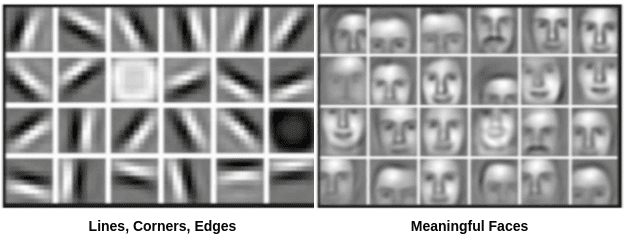1. 简介
计算机视觉(Computer Vision)是人工智能的一个重要分支,目标是让计算机能够理解和分析视觉数据(如图像和视频)。在这一过程中,特征提取(Feature Extraction)是关键步骤之一。特征是对图像内容的抽象表达,用于描述图像的结构、内容和语义信息。
根据抽象程度的不同,计算机视觉中的特征通常被划分为两类:
- 低级特征(Low-Level Features):如边缘、角点、颜色等
- 高级特征(High-Level Features):如物体、场景、行为等
本文将介绍这两类特征的区别、提取方式及其在实际任务中的应用场景。
2. 计算机视觉中的特征
在计算机视觉中,特征是图像或视频的某种可提取、可描述的属性。这些特征可以是图像的局部属性,也可以是整体语义的抽象表达。
示例特征:
- 低级特征:边缘(edges)、角点(corners)、颜色(color)、纹理(texture)
- 高级特征:物体(objects)、场景(scenes)、行为(actions)
特征的重要性:
- 帮助算法识别图像中的模式
- 支持后续任务,如分类、检测、分割等
- 通过组合低级与高级特征,可以实现更准确的图像理解
✅ 举个例子:
- 低级特征:识别图像中的边缘和角点
- 高级特征:基于这些边缘和角点,识别出一个“猫”或“汽车”的图像
3. 低级特征(Low-Level Features)
低级特征是从图像像素中直接提取的基本属性,通常是图像的局部信息。
常见类型:
- 边缘(Edges)
- 角点(Corners)
- 颜色分布(Color Histograms)
- 纹理(Texture)
提取方法:
- Canny 边缘检测器:用于提取图像中的边缘信息
- Harris 角点检测器:用于识别图像中的角点
- K-Means 聚类:用于颜色聚类或图像分割
特点:
- 与图像像素直接相关
- 易受噪声影响
- 局部性较强,对图像变化敏感(如光照、旋转)
4. 高级特征(High-Level Features)
高级特征是从低级特征基础上抽象出的语义信息,通常具有更强的泛化能力。
常见类型:
- 物体(Objects)
- 场景(Scenes)
- 行为(Actions)
提取方法:
- 卷积神经网络(CNN):擅长提取图像中的语义特征
- 循环神经网络(RNN):适用于视频或时序图像分析
- 预训练模型 + 微调(Fine-tuning):如 ResNet、VGG、EfficientNet 等
特点:
- 更具语义意义
- 抽象程度高,适合复杂任务(如图像分类、目标识别)
- 泛化能力强,适用于多种图像和视频
5. 低级与高级特征的区别
| 特征类型 | 抽象程度 | 提取方式 | 稳定性 | 应用场景 |
|---|---|---|---|---|
| 低级特征 | 低 | 手工提取(如 Canny、Harris) | 弱 | 图像分割、特征匹配 |
| 高级特征 | 高 | 深度学习(CNN、RNN) | 强 | 图像分类、目标识别 |
5.1 内容层面
- ✅ 低级特征贴近像素数据,对噪声敏感
- ✅ 高级特征更具语义意义,更易被人类理解
5.2 尺度层面
- ✅ 低级特征多为局部特征,易受图像变换影响
- ✅ 高级特征多为全局特征,考虑整个图像内容
5.3 资源消耗
- ✅ 低级特征提取资源消耗低(适合轻量级设备)
- ❌ 高级特征提取通常需要更多计算资源(如 GPU)
5.4 任务相关性
- ✅ 低级特征适合特定任务(如图像分割)
- ✅ 高级特征适合通用任务(如图像分类、行为识别)
示例图示:

6. 总结
本文系统地介绍了计算机视觉中低级特征与高级特征的概念、提取方法及区别:
- 低级特征:从像素中提取,如边缘、角点、颜色等,适合局部分析和特定任务
- 高级特征:从低级特征中抽象而来,如物体、场景等,适合语义理解和通用任务
✅ 在实际项目中,往往需要结合两者,才能实现更全面的图像理解和智能分析。
⚠️ 踩坑提醒:
- 在资源受限的场景下,使用低级特征可以节省计算资源
- 对于需要语义理解的场景,应优先考虑使用深度学习提取高级特征
参考资料:
- Canny Edge Detector
- Harris Corner Detection
- K-Means Clustering
- Convolutional Neural Networks (CNN)
- Transfer Learning & Fine-tuning Models
如需进一步了解特征提取的具体实现,建议参考 OpenCV、TensorFlow、PyTorch 等主流计算机视觉和深度学习框架的官方文档。